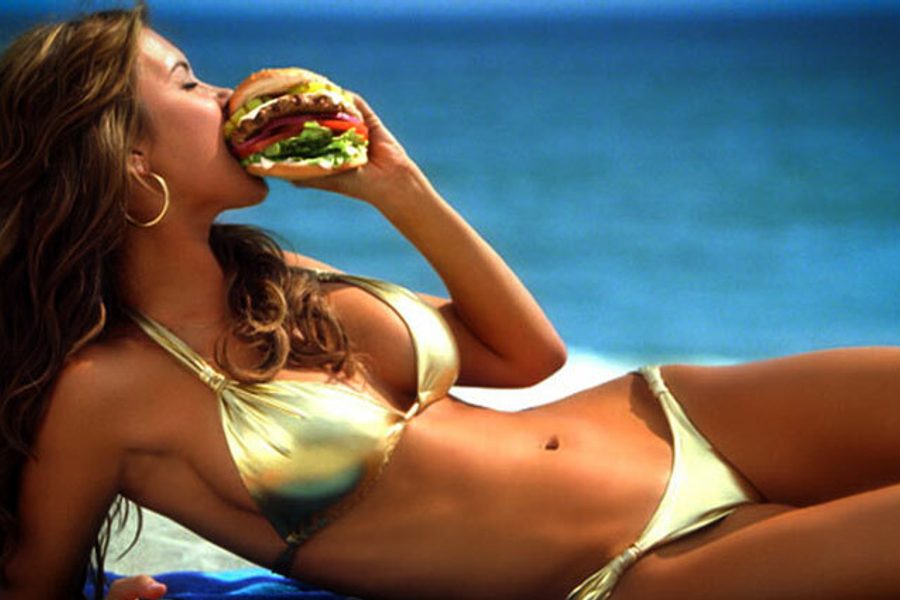
I am sitting here with two lurid magazine covers that represent a form of pornography that has become ubiquitous over the past decade: food porn. On my right is the latest issue of Saveur, a foodie publication that has sunk to celebrating “The World’s Best Donuts” and “The 50 Finest Donut Shops in America.” The cover features a money shot of one of the biggest hussies of the donut world, the chocolate glazed, and an equally tarty straw- berry-glazed “fonut” (steamed or baked, not fried). On my left is The New York Times Magazine, featuring an extreme close-up of a fried chip entering a very happy mouth; but titillation aside, this is an exposé of the food industry’s “addiction-creating battle for American ‘stomach share.’ ” One article says “chow down,” the other warns “look out.”
I’m not sure if our country has the sickest relationship to food on the planet, but we must come close. A TV ad for giant burgers, with fat and ketchup dripping slowly down the side of a bun, will be followed in a few minutes by an ad for Ultra Slim Fast. Women are policed by an impossible ideal of thinness and yet urged to eat a carton of ice cream when their boyfriend (and, yes, it’s always a boyfriend) breaks up with them. Advertisers equate fatty and sugar-laden food with having fun, making friends, rewarding oneself and, indeed, even having ersatz sex — while public health officials say eat more carrots and celery.
Our binge/purge society has one of the highest rates of obesity of any country in the world. Roughly two out of three U.S. adults are overweight or obese, rates that have more than doubled since 1980. In the same period, adolescent obesity rates have tripled. And today, one out of three U.S. children is overweight or obese.
So what is Saveur, allegedly a gourmet magazine, doing wetting its pants over globs of dough, fat and sugar? Why doesn’t it just call this “the Diabetes Issue”? Inside the magazine’s whopping 27-page special feature,“Donut Planet,” we are urged not only to “salute the sinker” but also to “learn how to make them at home.” Right. Recommended “tempting toppings” include bacon, Fruit Loops and M&Ms. We learn important historical facts, such as that in 2002, Eric “Badlands” Booker broke the record for most donuts consumed,“with 49 glazed donuts down the hatch in eight minutes.” Something worth aspiring to. The author, completing a book about desserts, learned that nearly “every civilization has some type of donut. The role that they played, however, came as a delightful surprise.” You mean making you fat, rotting your teeth and helping you develop hypertension and type 2 diabetes?
Saveur is hardly alone in this “to hell with healthy eating” stance. The Food Network features Paula Deen and her sugar/lard/cream/fat-packed recipes. For three years she concealed her type 2 diabetes. Then, once she had signed a contract with Novo Nordisk to become the spokesperson for Victoza, a $500-a-month injectable diabetes drug, she proclaimed the disease as some kind of badge of honor. Guy Fieri, host of Diners, Drive-Ins and Dives, relishes pigging out at down-home, fatty-food restaurants. It shows. And then there’s Adam Richman of Man v. Food, who celebrates gluttony as a masculine achievement by, for example, attempting to drink five large milkshakes in 30 minutes.
Meanwhile, at the New York Times, Michael Moss, drawing from his forthcoming book, Salt Sugar Fat: How the Food Giants Hooked Us, reports on “a conscious effort” by the food industry to get people hooked on processed foods. Food manufacturers hire experts on the relationship between the brain and food cravings, which has led some companies to elevate the amount of sugar or salt in a product until they find consumers’“bliss point.” So a serving of Prego tomato sauce, for example, can have as much sugar as “two-plus Oreo cookies.” Big Food also has a whole online engagement strategy for kids that includes games like “Big Chill Trails,” which asks you to “help Toucan Sam race through the snow to get to the Froot Loops®.”
It’s no surprise that Big Food uses every medium at its disposal to stoke Americans’ addiction to crap foods. But when allegedly high-toned food magazines and various food networks legitimate behaviors that contribute to a costly public health problem, it is time to call them out.
Susan J. Douglas is a professor of communications at the University of Michigan and a senior editor at In These Times. She is the author of In Our Prime: How Older Women Are Reinventing the Road Ahead.









